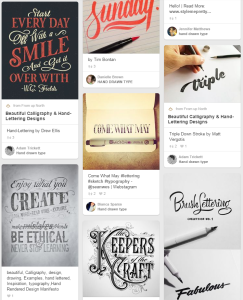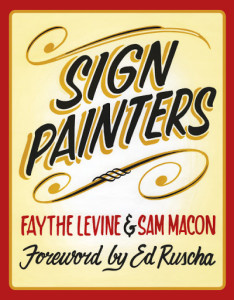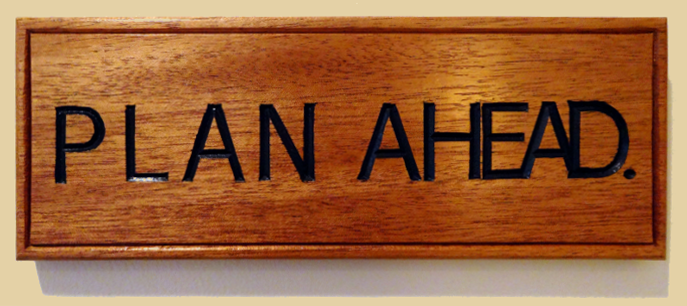Hand Lettered
Hand lettering is enjoying a resurgence. Decades of vinyl letter signs, “desktop publishing,” computer replicated fonts, and computer generated signs have left us with automated perfection that has become dull and uninteresting. Perfect replication of every line and curve is simply boring. Why? Because something is missing: evidence of a human hand.
 My son once asked why I leave facets in my carvings, why I don’t sand them to pristine smoothness. My quick answer was “to differentiate them from cheap Chinese carvings or the stuff that comes from CNC machines.” [It doesn’t hurt that I also hate sanding.] Just as facets left on a carving show us it was carved by a human, so do the little variations in hand drawn lettering make it almost immediately distinctive from computer generated material.
My son once asked why I leave facets in my carvings, why I don’t sand them to pristine smoothness. My quick answer was “to differentiate them from cheap Chinese carvings or the stuff that comes from CNC machines.” [It doesn’t hurt that I also hate sanding.] Just as facets left on a carving show us it was carved by a human, so do the little variations in hand drawn lettering make it almost immediately distinctive from computer generated material.
Discerning people are searching for humanity in the things they read, everything from web pages to signs, and a new generation of artists with hand lettering skills are thriving. Witness: these images. Witness: and these. They’re distinctive, they differentiate, and people are willing to pay handsomely for them.
Witness too the online education available to those wanting to learn hand lettering. One of the best of these is Sean McCabe’s Hand Lettering Course. The mere existence of his course, version 2 at $700 – up from $300 for version 1, shows strength in the resurgence of hand lettering.
Hand Painted – a Tribute to Sign Painters
Until 1982, nearly every sign you saw was hand either painted, or if needed in mass, lithograph printed. Just as today signs were everywhere, on store fronts, inside every kind of store, on churches, concert halls, theaters, hotels, on the sides of trucks, … everywhere.
Sign painters made them, by hand, with paint and brushes, hand lettered from “alphabets” in their heads. Not fonts, alphabets; the printing industry used fonts. Sign painters used alphabets. Sign painters were the ultimate hand letterers.
Dad was a sign painter and a photographer. Sign painting was his mainstay while he built up a solid photography business. He worked for a sign company, C.W. East, in Bloomington Indiana for a couple of decades during the middle of the last century. His primary work was paint on metal, outdoor advertising signs of all sizes, and signs on trucks. He had all manner of alphabets flowing from his mind through super flexible long bristled brushes. All of it was “hand lettered” before “hand lettering” became the term it is today. For many things, like the hundreds of ICC numbers on trucks, he used a simple chalk layout. For more precise larger work, he sometimes made a paper pattern and “pounced” it before painting. But in the end, it was all hand lettering, by eye, that made up the overwhelming bulk of his work … and fed a family with 4 children!
My introduction to lettering was watching him at work. No, as a child I didn’t get to visit the sign shop much, but he often had showcard work or silkscreen stencil work that he did in his home studio. I recall spending the better part of one summer cutting silkscreen stencils from his drawings, a story for another day. I’ll also save for another day a story about a gold gilded sign on glass.
Dad completed his move from sign painting to photography by the early 1960s. He left sign painting behind except for occasional jobs.
1982?
That’s when computer driven plotters started cutting vinyl letters. Sign painting was never the same after that. Dad was gone by then, never learning about how much his former trade changed. Nor, did he see what “digital” did to photography.
Recently, Faythe Levine and Ed Ruscha, exploring “hand made” work of all kinds, settled on sign painters as one genre they wanted to document. One of their results was a film…
 A companion to the film is a book of the same name. It is a collection of vignettes profiling 25 sign painters. The common theme running through the material laments the 1982 arrival of a computer driven plotter that cut vinyl letters. Thousands of sign painters abandoned hand painting for vinyl. Fortunately, for those of us who appreciate hand lettering, many did not.
A companion to the film is a book of the same name. It is a collection of vignettes profiling 25 sign painters. The common theme running through the material laments the 1982 arrival of a computer driven plotter that cut vinyl letters. Thousands of sign painters abandoned hand painting for vinyl. Fortunately, for those of us who appreciate hand lettering, many did not.
Wander over to Vimeo, a video publishing service, and search for “Sign Painter.” There are 235 results, short videos about sign painters, many of them quite young and apparently thriving. Here too, there are discerning customers willing to pay more for hand painted signs.
Hand Carved
My interest in hand lettering is enjoying a resurgence too. I’ve hand carved a few signs in recent years, and have enjoyed making them. I’ll be doing more.
Old signs become art.I want to make signs that turn into art.Phil Vandervaart – Sign Painters film
To be clear, for me “hand carved” means with chisels and gouges, NOT with routers, sand blasters or CNC machines. And before there’s hand carving, there’s hand lettering. I draw and redraw lettering with good old paper and pencil and drafting tools until I get the look I want. Then, I might scan the last drawing and use the computer to store the pattern that can be used again.
The carving at the top of this page is my rendition of a drawing at the end of the Forward section of the Sign Painters book. My sign is hand drawn and hand carved on mahogany. 4 1/4″ x 10 1/2″. Acrylic paint in the letters and shellac finish.

Thanks for this blog Bob, definitely will try to find that on Vimeo. In the late 70’s my neighbor did sign painting out of his garage, fascinating. When my wife worked as a graphic artist here in the Golden Nugget she would go to sign painters for work and said they were usually quite interesting characters!
“Quite interesting” indeed! As one of the guys in the film said, “sign painters are characters.” And as I wander through all of the vignettes, I’m struck most of all by how many have body art. As a child of the 1940s, I came through several decades where tattoos denoted the most unsavory of people and were universally despised by most people. (and of course, Dad would have none of that.) Times change.
I think we, as a society, have become tired of the sterile, mass produced, elements that surround us. Cookie-cutter houses, flat-pack furniture and computer generated signage. People crave a little style/art in their everyday lives. Up until very recently we defined objects by the style in which they were made. Edwardian, colonial, shaker, art deco and mid-century modern to name a few. What style defines the current era? Most people can’t name what is missing, they just know that something is lacking.
Add to that, the basic skills needed for hand lettering signs. Layout, measuring, ratios for mixing paints and basic spelling! So many people lack these basic skills, let alone the artistic talent required for such a task.
I wonder how many people have read the words on your plaque above and failed to grasp the visual message of it? “We” are no longer trained to look for those types of visual clues. Words have been reduced to text speak and emoji. Speed and cost are king, quality and style be damned. End rant.
As to the above hand painted signs. The skill is most definitely an underrated art form and I’m glad to see that it is making a resurgence. I think I’ll have to buy the book and take a trip down yet another rabbit hole. If nothing more than for my own visual pleasure. Thanks for sharing this one.
Greg
Thanks Greg,
You said “and basic spelling!” When Dad was working at the sign shop, he always came home for lunch. There were often stories about how the day was going at the shop, a constant litany of stories about Chuck or Hank (the brothers who owned the place.)
The stand-out lunchtime I still remember is the day he ranted all through lunch and then made a point of taking the family dictionary back to work, to show Hank the correct spelling of a word they were arguing about.
BTW, I forgot to link to the film. Here.